Tychy- Silesian 作者: 来源: 发布时间:2021-10-27
Ⅰ. Population and Area
Population (31 December 2019)
• City 127,590 Decrease (28th)
• Urban 2,746,000
• Metro 4,620,624
Area
• City 81.64 km2 (31.52 sq mi)
Website https://umtychy.pl/
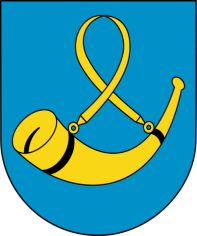
Ⅱ.Natural Geography (environment and resources)
-A city in the Silesian Voivodship (Upper Silesia) in southern Poland, Tychy is bordered by Katowice to the north, Mikolow to the west, Bierun Stary to the east and Kobior to the south. It lies on a rail and road junction linking Warsaw with Krakow and Vienna. Tychy is situated 30 km from the Czech border and 55 km from the border with Slovakia, and has a population of roughly 129,000 inhabitants within an area of 82.63 km2.
-This is an industrial city in the basin of the Vistula River. It is located within the area lying between the Oswiecimska Valley and the Slaska Upland, while nearby, only some 25 km away, stretch two minor mountain ranges – the Beskid Slaski and Beskid Zywiecki.
-Transport
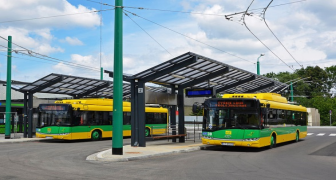
-Two trolleybuses at Tychy railway station
-In Tychy operates one of three remaining trolleybus systems in Poland.
-Roads
-Expressway S1
-National road 1
-National road 44
-National road 86
Ⅲ.Economy
-A large Fiat car factory is located in Tychy that was opened in 1975, and is owned by the Italian manufacturer since 1992. In 2008, the factory had a production of nearly half a million cars. It produces the new Fiat 500 and the new Lancia Ypsilon. It was the exclusive manufacturing site for the second generation Fiat Panda until 2012, when it ended production, and of the 2nd generation Ford Ka (under an OEM agreement between the two manufacturers) until May 2016.
-Also in Tychy is located the GM Powertrain Poland factory producing automobile engines for General Motors cars. This plant was opened by Isuzu as Isuzu Motors Polska (ISPOL) in 1996; 2002 GM took over 60% interests of that company, and in 2013 the remaining 40%.
-The Tyskie beer is produced in Tychy, by Kompania Piwowarska, a subsidiary of the multinational brewing company SABMiller. It is reportedly one of the best-selling brands of beer in Poland, with around 18% share of the Polish market as of 2009.
-Tychy - Wikipedia https://en.wikipedia.org/wiki/Tychy
Ⅳ.Industrial Characteristics
-Tychy is well known for its brewing industry and its international developed brand Tyskie, which dates back to the 17th century. Since 1950 Tychy has grown rapidly, mainly as a result of post-war socialist planning policies enacted to disperse the population of industrial Upper Silesia.
-Tychy - Wikipedia https://en.wikipedia.org/wiki/Tychy#Industry
Key projects
-1. Implementation of the RES program
-The city of Tychy is starting the implementation of the project entitled: "Renewable energy sources as a chance to improve air quality in Tychy". The Program Operator was selected, and the Grantee Service Point (POG) was launched, located in the Centrum Balbina building at ul. Baron 30 in Tychy.
-News - News - Tychy https://umtychy.pl/aktualnosci
-2. A new Park & Ride car park will be built in Tychy
-The Park & Ride and Bike & Ride multi-storey car park will be built at the intersection of Wyszyńskiego and Edukacji streets in Tychy. The Tychy City Hall has just received information about granting PLN 11.5 million of funding for the implementation of this investment, estimated at PLN 14.9 million.
Ⅴ.Attrations and Cityscape
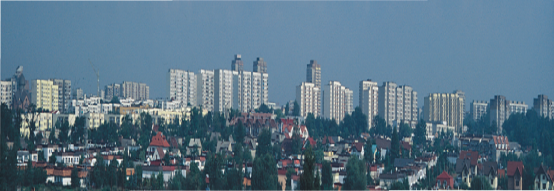
Panorama of Tychy
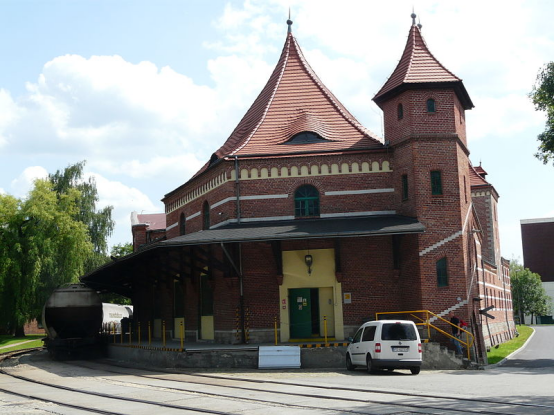
Old railway building at the old brewery
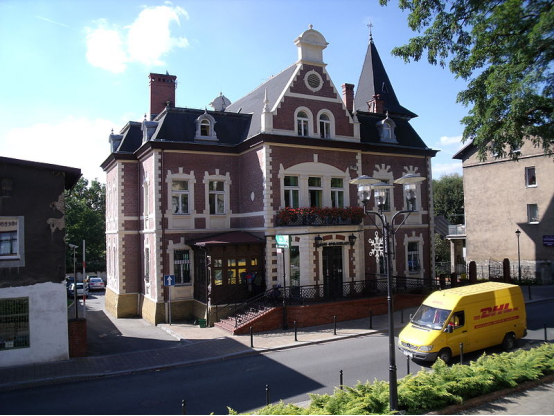
Cooperative bank in the city centre
-Points of interest in the city include a palace and park complex from the 18th century, the Paprocka Steel Works, the St. Mary Magdalene Church and the Hunter’s Manor of the Pszczyna Princes in Promnice. You are also recommended to see the edifices housing Tyskie Browary Ksiazece (the Tychy Prince Brewery), painstakingly restored under the supervision of the local conservator of historical monuments and which now form a splendid example of the country’s industrial architecture.
-Cielmice is situated south-east of the city’s downtown area and actually constitutes a part of Tychy. Due to the lack of apartment buildings and a large number of tiny houses, the area has a unique, village-like appearance.
-Emblematic for the city are ancient chapels with stone figures of miscellaneous saints, as well as the roadside crucifixes that once marked Tychy’s major traffic arteries. You are sure to run across a lot of them while roaming around the city.
-Apart from the many historical monuments, Tychy offers a good choice of pubs, bars and restaurants to help pass some time. One may also take advantage of the city’s cultural offerings, and amongst the many events held throughout the year are some of national importance, such as the Tychy Carolling Eves in January, Tychy Theatrical Meetings in April and the Tychy May Seminar.
Ⅵ.History and Culture
-Etymology
-The moniker Tychy is derived from the Polish word cichy, meaning "quiet" or "still". Although appropriate for most of Tychy's history, the name is now somewhat ironic considering the growth of the city from 1950 onwards.
-Origins and development
-St. Mary Magdalene Church in the Stare Tychy district
-Originally established as a small agricultural settlement on the medieval trade route between Oświęcim and Mikołów, Tychy was first documented in 1467. In 1629 the first trace of serious economic activity was recorded in the shape of the Książęcy Brewery, which is now one of the largest breweries in Poland.
-From 1526 onwards the area on which Tychy is built was part of the Austrian Habsburg Monarchy. This situation came to an end when Prussia forcibly took the land in 1742, before itself becoming part of the German Empire between 1871 and 1918. For a short period between 1918 and 1921 Tychy was just inside the border of the newly formed Weimar Republic and still a part of the German Province of Silesia, and on 16–17 August 1919 the Battle of Paprocany (present-day district of Tychy) was fought as one of the first battles of the Silesian Uprisings (1919 to 1921). After the uprisings Tychy was reintegrated with the re-established Polish state.
-Shortly after its cession to Poland, Tychy began to develop into a small urban settlement, acquiring a hospital, a fire station, a post office, a school, a swimming pool, a bowling hall and a number of shops and restaurants. In 1922 it was visited by leader of interwar Poland, Józef Piłsudski. Its population also grew between World War I and World War II, reaching a population of 11,000 at its highest point during this time.
-World War II
-Memorial to Poles murdered by the Germans in the last public execution in Tychy on September 22, 1944
-Along with the rest of industrial Upper Silesia Tychy was occupied by Nazi Germany forces after the invasion of Poland and annexed into the Third Reich, while many of its inhabitants who were not expelled or exterminated were forced to change their nationality to German in order to comply with the racist policies of Nazi Germany. Mass arrests and executions of Polish activists and former Polish insurgents of 1919–1921 were carried out in the first days of the occupation in September 1939. As early as September 3, 1939, the Germans murdered several Polish residents of the city, of whom 13 were later identified; the youngest was 16 years old. The last public execution was carried out on September 22, 1944, when five members of the underground Polish resistance movement were killed. Tychy received minimal damage during the invasion because most of the nearby fighting took place in the Mikołów-Wyry area. The E701 working party of the Stalag VIII-B/344 prisoner-of-war camp was located in the present-day Czułów district.
-Tychy was liberated on January 28, 1945.
-New Tychy
-Osiedle A in Tychy, built in the 1950s
-The "New City" was designated by the Polish government in 1950 and deliberately located near to Katowice with the intention that it would not be a self-sustaining city. It was granted town rights in 1951. Tychy is the largest of the so-called "new towns" in Poland and was built from 1950 to 1985, to allow for urban expansion in the southeast of the Upper Silesian industrial region. In the 1950s the neighbourhood Osiedle A was built, designed by Tadeusz Teodorowicz-Todorowski, and the design and planning of the next neighbourhoods was entrusted to Kazimierz Wejchert and his wife Hanna Adamczewska-Wejchert. In the 1950s, 1960s and 1970s numerous industrial enterprises were created. In 1951 and 1973 the city limits were greatly expanded by including Paprocany and Wilkowyje (in 1951), and Cielmice, Urbanowice, Jaroszowice (in 1973) as new districts. By 2006, the population had reached 132,500.
-In the administrative reforms which came into effect in 1999, Tychy was made a city with the status of a powiat (City County). Between 1999 and 2002, it was also the administrative seat of (but not part of) an entity called Tychy County (powiat tyski), which is now known as the Bieruń-Lędziny County.
-Brewery in Tychy on the right, Tyskie Brewing Museum on the left
-The Tyskie Brewing Museum was founded in 2004, and the Municipal Museum in 2005.
-Sport
-Tychy is home to two major sporting teams, both named GKS Tychy. GKS stands for Górniczy Klub Sportowy, (English: Miner's Sporting Club), which is a common prefix for Polish sports teams situated near mines or in mining regions.
-Ice hockey
-GKS Tychy celebrating the Polish championship in 2018
-GKS Tychy ice hockey club is among the most successful in Poland and plays in its premier league, the Ekstraliga. Established in 1971, the team won the Polish Championships in 2005, 2015, 2018, 2019 and 2020 and has won the Polish Cup eight times. The club is housed in the newly refurbished Tychy Winter Stadium (Polish: Stadion Zimowy w Tychach), which seats 2,700 people.
-Several players from the club have gone on to play in the American and Canadian NHL. These include Mariusz Czerkawski and Krzysztof Oliwa.
-Football
-Tychy City Stadium, home to the GKS Tychy football club
-GKS Tychy football club football club was also established in 1971 and currently plays in the Polish Second League. Throughout a varied career the club reached a pinnacle between 1974 and 1977, making it into top Polish league Ekstraklasa and finishing second in 1976.[9] During those glory days GKS Tychy also participated in the 1976–77 UEFA Cup. It played in the top division again in 1995–1997. Tychy City Stadium (Polish: Stadion Miejski w Tychach) is home to the club and seats 15,300 spectators.
-A few notable footballers were either born in Tychy or spent some of their career at the club, the most famous being Real Madrid and Poland goalkeeper Jerzy Dudek. Ekstraklasa player Bartosz Karwan started his career there, as did retired player Radosław Gilewicz. Napoli and Poland national team striker Arkadiusz Milik was born in Tychy, as well as former Bayer Leverkusen defender Lukas Sinkiewicz, who now holds German citizenship.
-Tychy hosted several matches of the 2019 FIFA U-20 World Cup.
-Other sporting teams
-Tychy is also home to several other sports teams, including basketball team Big Star Tychy, futsal team GKS Jachym Tychy and floorball team TKKF Pionier Tychy.
Ⅶ.Other Information
-Tychy is a city in Silesia, Poland, approximately 20 kilometres (12 mi) south of Katowice. Situated on the southern edge of the Upper Silesian industrial district, the city borders Katowice to the north, Mikołów to the west, Bieruń to the east and Kobiór to the south. The Gostynia River, a tributary of the Vistula, flows through Tychy.
-Since 1999 Tychy has been located within the Silesian Voivodeship, a province consisting of 71 regional towns and cities. Tychy is also one of the founding cities of the Metropolitan Association of Upper Silesia, a pan-Silesian economic and political union formed with the eventual aim of bringing the most populous Silesian areas under a single administrative body.
Ⅷ.Contact Information
-Mayor Andrzej Dziuba
-Tychy City Hallal. Niepodległości 4943-100 Tychy
-headquarters: 32 776 33 33,
-fax: 32 776 33 44
-e-mail: post@umtychy.pl
-Office hours:
-7.30 to 15.30 Mondays, Tuesdays, Wednesdays
-7.30 to 17.30 Thursdays
-7.30 to 13.30 Fridays
-Press Officer - Eve Grudniok
-tel. 32 776 39 55
-e-mail: rzecznik@umtychy.pl
-NIP of the Tychy Commune: 646-00-13-450
-REGON of the City with Poviat Rights: 276255507
-REGON of the City of Tychy: 000515922
